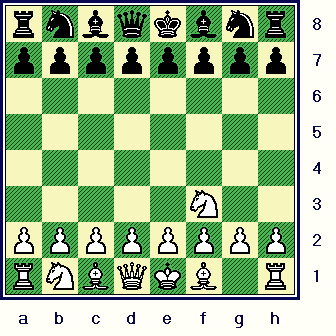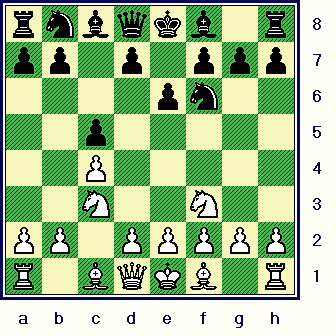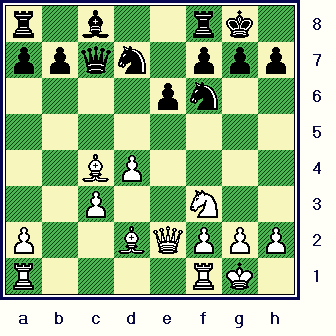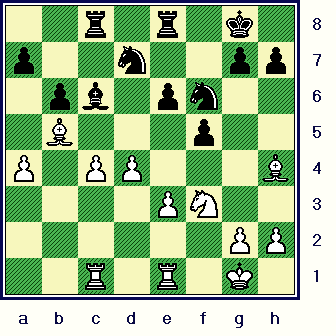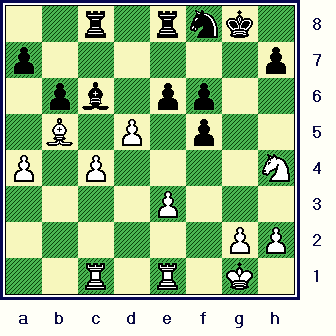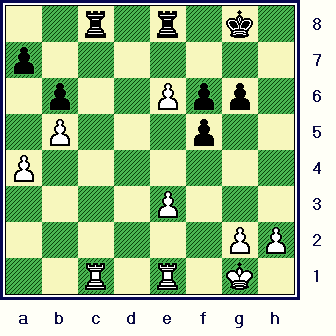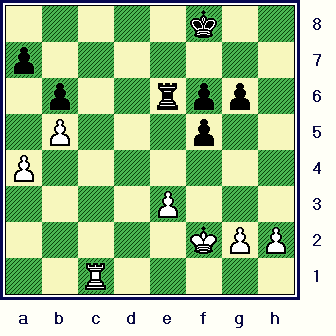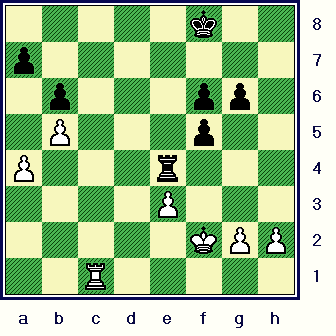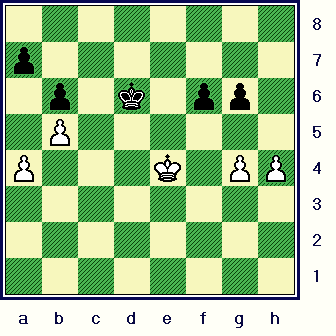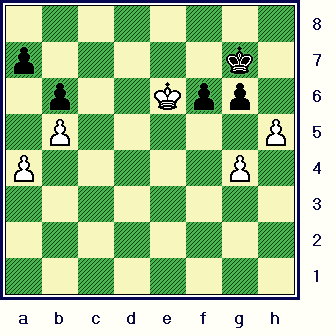GM K. Sasikiran (2675) -
GM L.D. Nisipeanu (2696)
[E54]
ESP-chT Honor (Gp1)
Olite,
ESP (Round
# 01) / 05,09,2006.
[A.J. Goldsby I]
This is for my "GOTM" column for
the month of September, 2006. (Please consult TWIC #
618.)
GM K. Sasikiran does not get a lot of
attention ... his countryman, Vishy Anand usually steals the limelight. However Sasikiran is a "Top 100" GM,
and shows his skills in this interesting and topical encounter.
****************************************************************************************
1.Nf3,
The Reti Opening.
rnbqkbnr/pppppppp/8/8/8/5N2/PPPPPPPP/RNBQKB1R b
This opening can be a real bear to play ... or play against. The reason? In a moments notice, play can transpose to virtually any other opening.
For example, after 1...Nc6; 2.e4, e5; we have transposed to a KP opening. After 1...d5; 2.d4, Nf6; 3.c4, we
could have a Queen's Gambit.
[In fact, the only opening, (right now); that has been ruled out would be the King's Gambit.
{The Knight on f3 blocks the KBP.}]
Because of the nearly infinite possibilities of the openings (and P-structures) that can present themselves, even a master can go astray in this opening.
1...c5;
This is a perfectly reasonable reply, Black hits the key center square. (d4) [Of course, after 2.e4, d6; we have transposed {again}, this time into a modern variation of the Sicilian
Defense.]
Black could also play 1...Nf6 or even 1...g6. In that way, we could transpose into any of the hyper-modern openings, or even a King's Indian/Modern Defense.
It USED to be my personal preference to ALWAYS ... at least try to play ... the "Lasker's Defense" against the Reti opening. However, I discovered that after 1...d5; White can "trick" you and play 2.d4, when play is now in the realm of the double-QP opening. (This discovery made 1...d5 unusable when playing lower-rated players.)
[ After the moves: 1...d5;
2.c4 c6; 3.b3 Nf6;
Maybe the most flexible move that Black can play here.
** ** ** ** ** ** **
** ** ** ** ** ** **
** ** ** ** ** ** **
** ** ** ** ** ** **
( One of the earliest examples of a good way to meet the Reti was shown by the old master himself:
3...Bf5!?; 4.g3 Nf6; 5.Bg2 Nbd7; 6.Bb2 e6; 7.0-0 Bd6;
8.d3 0-0; 9.Nbd2 e5;
10.cxd5 cxd5; 11.Rc1 Qe7; 12.Rc2 a5; 13.a4 h6;
"~" ("=/+")
with good play for Black.
R. Reti - E. Lasker; /
ICT, New York, 1924. {Black won a nice game.} )
** ** ** ** ** ** **
** ** ** ** ** ** ** ** ** ** ** ** ** **
** ** ** ** ** ** **
4.g3 Bg4!;
The second player develops his Queen's Bishop outside the pawn chain for active play here.
(Black can also play the Bishop to the f5-square as well, see the note just below.)
** ** ** ** ** ** **
** ** ** ** ** ** **
** ** ** ** ** ** **
** ** ** ** ** ** **
( Black also gets a good game by playing the Bishop to f5, ... ... ...
for example:
4...Bf5; 5.Bg2 e6;
6.Bb2 Nbd7; 7.0-0 h6;
8.d3 Be7; 9.Nbd2 0-0; "~"
when Black has a solid position.
GM P. Harikrishna (2646) - GM L. Dominguez (2658) / [A12]
ICT, Masters A /
Dos Hermanas, ESP; (9) / 01,04,2005.
{After some wild complications, this was
drawn in 31 moves.}
[ See also MCO-14, page # 706; column # 04 and all relevant notes. ]
)
** ** ** ** ** ** **
** ** ** ** ** ** **
** ** ** ** ** ** **
** ** ** ** ** ** **
5.Bg2 e6; 6.0-0 Nbd7; 7.Bb2 Bd6; 8.d3
0-0; 9.Nbd2 Qe7; 10.a3 a5; "="
Black has no problems in this position - and went on to win a nice game in 49 moves.
GM Joerg Hickl
(2602) - GM Alexander Beliavsky
(2650); / [A12]
/
National TT
(Bundesliga - 0203) Germany,
(R8) /
19,10,2002.
[ See also MCO-14, page # 706; column # 06, and all notes that relate to the various columns. ]
] 2.c4,
OK, right now it looks like an English Opening to me. (The symmetrical system.)
[ White could also play: 2.b3!?,
(The Nimzovich - Larsen system). ] 2...Nf6;
3.Nc3 e6;
With this move, Black seems to be angling for a QP opening, if Black had instead played 3...g6; any number of openings could have resulted. (English, Sicilian, or even a King's Indian Defense.)
rnbqkb1r/pp1p1ppp/4pn2/2p5/2P5/2N2N2/PP1PPPPP/R1BQKB1R w
Please take a look at this position for just a minute.
[ After the moves:
3...Nc6; 4.d4 cxd4;
5.Nxd4 g6; 6.e4 d6;
we have transposed into a Sicilian - Maroczy Bind formation.
] 4.e3 d5;
5.d4,
White's last move vigorously contests the center, and right now I could swear that the opening was a
Semi-Tarrasch.
(E.g., 5...Nc6; 6.a3!)
[ After the moves:
5.cxd5 exd5; 6.d4, "+/=" we have transposed into the
older lines of the Tarrasch Defense without a king-side fianchetto by White.
] 5...cxd4;
6.exd4 Bb4;
Black pins White's Knight, but putting the Bishop on e7 looked more dynamic.
And now I would think that the opening was a Ragozin System of the Queen's Gambit Declined.
Note that after Black plays the exchange ...d5xc4, we will have reached a position where White has an isolated QP, perhaps the best
book on this subject would have to be:
"Winning Pawn Structures,"
by GM Alexander Baburin.
7.Bd3!?,
White plays a normal developing move, and also seems to be daring his opponent to capture on c4.
[ Another way for White to proceed was:
7.cxd5
Nxd5; 8.Bd2 Nc6; 9.Bd3 0-0; 10.0-0
Be7; 11.a3 Bf6; 12.Qc2 g6!?;
13.Bh6
Re8; 14.Rad1, "+/="
GM Alexander Riazantsev
(2608) - GM Victor Bologan
(2700) / [B14]
ICT, 6th EICC /
Warsaw, POL (R4) / 21,06,2005.
{Drawn in thirty-three moves.} ] 7...dxc4;
8.Bxc4 Qc7;
9.Qe2 0-0; 10.0-0 Bxc3;
Black seems to jump the gun with this move, I would have preferred to hang onto my Bishop and play 10...Nbd7 here instead.
(However, this is the first choice of the 2006
"Fritz Power-Book.") 11.bxc3 Nbd7;
This is a normal move here, another idea was for Black to play 11...b6; (to fianchetto his QB). 12.Bd2,
"+/="
A perfectly normal developing move, however both Ba3 and Bg5 looked more aggressive ... and both moves deserve serious investigation.
r1b2rk1/ppqn1ppp/4pn2/8/2BP4/2P2N2/P2BQPPP/R4RK1 b
White's two Bishops should guarantee this first player a small advantage, after many twists and turns,
... ... ...
the opening has finally settled (transposed) on that of the Nimzo-Indian. [E55]
(The normal move order is: 1.d4 Nf6; 2.c4 e6; 3.Nc3 Bb4; 4.e3 0-0; 5.Nf3 d5; 6.Bd3 c5; 7.0-0 dc4; 8.Bc4 Nbd7; etc.)
[ The main line ... at least, according to the "Power-Book" would be:
(>/=) 12.Bg5
b6; 13.Rac1 Bb7; 14.Bd3 Ng4; 15.Be4
Bxe4; 16.Qxe4 Ngf6;
17.Qe2
Rac8; 18.c4,
"+/=" with an edge for White.
One GM example would be:
Jonathan Speelman (2620) - Lev Polugaevsky (2630); /
National Champ. Tourn.
(NED-chT);
The Netherlands, 1992.
{White won, 1-0 in 39 total moves.} ] 12...b6;
With the Pawn on e6 and the BN currently on d7, the easiest and quickest way for the second party to develop the QB is via the fianchetto. 13.Bd3 Bb7;
14.Rac1 Rfe8; 15.Rfe1 Qd6; (TN?)
Black avoids a repetition of moves, and prepares to centralize his Rooks.
(As far as I can tell, Black's last move was new to master-level practice.)
[ A popular drawing line - which was used to circumvent a FIDE rule against draws before move thirty -
was the continuation: 15...Nd5;
16.Qe4 N5f6; 17.Qe2 Nd5; 18.Qe4 N5f6;
19.Qe2,
etc. {Draw.}
L. Sapi - J.
Flesch; [E54] /
HUN-ch Budapest, 1969.
] 16.Bg5 Rac8;
17.Bh4,
White decides to maintain the combination of two long-range Bishops.
[ Maybe 17.Ba6!?, "+/=" here?
] 17...Nh5!;
Black finds a nice saving resource, now the next few moves are very close to being forced. 18.Qe3 Qf4;
19.Bb5 Bc6;
20.a4!? Qxe3!?;
Black might have been a little too eager to swap the Queens, the simple 20...f6; (as suggested by Fritz 9.0) was probably a little better.
[ But not: </=
20...Bxf3?;
21.Bxd7,
"+/-" as White wins material. ] 21.fxe3 f5;
22.c4,
White gains a little more space.
[ Possibly (>/=) 22.Nd2, "+/="
('!') here? ] 22...Nhf6;
White still would have the advantage after 22...e5; 23.h3, "+/="
but this might have been better than the game.
2r1r1k1/p2n2pp/1pb1pn2/1B3p2/P1PP3B/4PN2/6PP/2R1R1K1 w
A critical position has been reached, due to his better pawn structure, the first player holds the upper hand. 23.Bxf6,
This leads to a solid edge for White. Also good for White was 23.Ba6, (see the note just below).
[ After the continuation of:
>/=
23.Ba6! Ra8; 24.Bg3! Ne4;
25.Ne5 Nxe5; 26.Bxe5 Re7;
( </= 26...Bxa4?!; 27.Bb7 Rad8;
28.Ra1 b5 ; 29.Bc6 Re7;
30.cxb5 Bb3; 31.Ra6 Bd5; 32.Rea1, '±');
27.Ra1, "+/=" ("+/") White is clearly on top.
] 23...gxf6;
This is virtually forced for Black.
[ After the positionally inferior:
</=
23...Nxf6?; 24.Ne5 Bxb5;
25.axb5 Rc7; 26.Ra1, '±'
Sasikiran will win just by piling up on Black's a-pawn.
] 24.Nh4 Nf8;
25.d5!,
A critical breakthrough.
2r1rnk1/p6p/1pb1pp2/1B1P1p2/P1P4N/4P3/6PP/2R1R1K1 b
Now Black will be left with doubled and isolated pawns in the f-file. However, a lot of Pawns are coming off the board, which increases the second player's drawing chances. (Plus Nisipeanu still has considerable piece activity, Sasikiran must first neutralize this to win.) 25...Bxb5;
26.cxb5 Ng6!?;
Nisipeanu understandably takes advantage of the fact that White's Knight on h4 is unprotected, and decides to force this exchange in order to repair his pawn structure.
[ Maybe a little better was:
26...exd5;
27.Nxf5 Ng6;
("<=>") {D?}
when White still has a number of technical problems to overcome.
] 27.Nxg6 hxg6;
28.dxe6,
White is ahead a Pawn, but this is only a temporary situation, with correct play, Black should be able to reestablish material equality.
2r1r1k1/p7/1p2Ppp1/1P3p2/P7/4P3/6PP/2R1R1K1 b
Please study this position for just a few minutes. 28...Kf8?!;
This is not the best defense, and opens a window of opportunity for his opponent that should have remained closed.
[ >/=
28...Rxc1;
29.Rxc1 Rxe6;
30.Kf2!? Re7; "="
] 29.Red1,
('!?')
Rather than trade down, Sasikiran decides to improve his position.
[ After the variation: (>/=)
29.Rxc8 Rxc8;
30.Rd1,
"+/="
White looks to be solidly better. (Maybe "+/")
] 29...Rxc1;
30.Rxc1 Rxe6;
31.Kf2,
Now we have reached the turning point of the whole game.
5k2/p7/1p2rpp1/1P3p2/P7/4P3/5KPP/2R5 b
White has a slight advantage, yet with precise play, it is hard to see how
Sasikiran would have won this particular encounter.
31...Re4?;
To play this move, Black must have been in time pressure, or has severely underestimated just how bad the coming K+P endgame will be for him.
After the simple >/= 31...Re7[];
"~" {Maybe equal.} (which guards the crucial seventh rank); it is difficult to see how White can make real progress. *** *** *** *** *** *** *** *** *** *** *** *** *** *** *** *** *** *** *** *** *** *** *** *** *** *** *** *** ***
5k2/p7/1p3pp1/1P3p2/P3r3/4P3/5KPP/2R5 w
Now what follows could be considered a lesson in K+P endings.
32.Rc8+ Kf7; 33.Rc7+ Re7[];
(Otherwise Black loses a Pawn for nothing.)
34.Rxe7+ Kxe7; 35.Kf3 Kd6;
It really does not matter how Black plays this position, after over a week of computer-assisted analysis, I am convinced that Black cannot save his position. (One student e-mailed me and said that this move was an error, yet Fritz 9 sees little or no difference between this play and 35...Ke6.)
[ After the artful continuation:
35...Ke6!?; 36.h3!! Ke5;
This is just about forced.
** ** ** ** ** ** **
** ** ** ** ** ** **
** ** ** ** ** ** **
** ** ** ** ** ** **
( After the moves: (</=)
36...g5!?; 37.g3! Ke5; 38.h4, ("+/-")
White has made a passed KRP that will decide the game. )
** ** ** ** ** ** **
** ** ** ** ** ** **
** ** ** ** ** ** **
** ** ** ** ** ** **
37.h4 Kd5; 38.Kf4 Ke6;
39.h5! gxh5[]; Forced.
** ** ** ** ** ** **
** ** ** ** ** ** **
** ** ** ** ** ** **
** ** ** ** ** ** **
( After the continuation of:
39...g5+; 40.Kf3 Kf7;
[The BK cannot step forward, as White plays h5-h6. ("+/-")]
41.e4 f4; 42.Kg4 Kg7;
43.e5! fxe5; 44.Kxg5 Kh7;
45.Kf5 Kh6; 46.Kxe5 Kg5;
47.h6 f3; 48.gxf3 Kxh6;
49.f4, "+/-" ... the K+P ending is a simple win for White. )
** ** ** ** ** ** **
** ** ** ** ** ** **
** ** ** ** ** ** **
** ** ** ** ** ** **
Now after White's next move, Black must move and give back a button.
40.g3,
(Black is now in Zugzwang.) 40...Ke7; 41.Kxf5
Kf7; 42.e4, "+/-"
Several different engines confirm that although material is equal, the first player should
win from here. (I found several different ways for White to win, it would be impossible to
analyze all of the branches. If the following variation does not convince you, then fire up
your own program and work it out for yourself.)
*******************************************************************
*******************************************************************
( After the following moves:
42.e4 Kg7;
43.e5! fxe5;
44.Kxe5 Kg6;
45.Kd5
Kg5; 46.Kc6 Kg4; 47.Kb7 Kxg3;
48.Kxa7 h4; 49.a5! bxa5!?;
The only way to make the game interesting, the Q+P ending is a boringly
simple win for White.
** ** ** ** ** ** **
** ** ** ** ** ** **
** ** ** ** ** ** **
( After the following moves: (>/=) 49...h3;
50.axb6 h2;
[The following moves/analysis comes from the 5-DVD set of the Nalimov
Endgame
Tablebases. ("Turbo 2")]
51.b7 h1Q;
52.b8Q+ Kg4; 53.Qc8+ Kf4; 54.Qc4+ Ke3;
55.Qc3+ Ke2; 56.b6, "+/-"
{While complicated for a human to play, this ending is rather routine for the computer.
Any endgame book easily identifies this position as a win for White from here, the
CB engine, Tablebase 3.2 shows this as a "mate in 30 moves."}
Click here
to see the analysis of this endgame. )
** ** ** ** ** ** **
** ** ** ** ** ** **
** ** ** ** ** ** **
50.b6 h3;
51.b7 h2;
52.b8Q+ Kg2; 53.Qb2+ Kg1;
54.Qd4+ Kg2;
55.Qg4+
Kf2; 56.Qh3 Kg1; 57.Qg3+ Kf1;
If 57...Kh1?; then White just plays 58.Qf2 to be followed by 59.Qf1 mate ...
there is no stalemate, thanks to the Black QRP on a5.
58.Qxh2,
"+/-" ... and the win is now relatively simple from here.
)
]
36.Kf4 Kd5!?;
Trying to vary the play? At any rate, it no longer matters.
[ The moves of
= 36...Ke6;
37.h4,
simply transposes into the last note. ] 37.h4 Ke6;
38.g3 Ke7;
(Or if 38...g6-g5+!?; White simply plays 39.Kf3! and wins - due to the power of the passed pawn.) 39.e4!,
White could also win with h4-h5; but the text is more accurate.
[ White could have also played:
39.h5!? Kf7;
This was forced.
( Or if: 39...gxh5; 40.Kxf5 Kf7; and now 41.e4,
"+/-" winning. )
40.hxg6+ Kxg6; 41.e4! fxe4;
42.Kxe4 Kg5; 43.Kd5!, "+/-"
when White wins ... but this line was probably extremely difficult
to calculate over the board. ] 39...fxe4;
40.Kxe4 Kd6;
40...Ke6; 41.g4, is just a simple transposition. 41.g4,
Take a look at the current position that we now have on the board.
8/p7/1p1k1pp1/1P6/P3K1PP/8/8/8 b
One of the keys to this position is that Black is unable to handle the outside passed pawn that White can generate by advancing his KRP. 41...Ke6;
42.h5 Kf7; 43.Kd5 Kg7; 44.Ke6, "+/-" Black Resigns.
8/p5k1/1p2Kpp1/1P5P/P5P1/8/8/8 b
Nisipeanu quits, after 44...gxh5; 45.gxh5, Kh6; 46.Kxf6, Kxh5; White wins easily by running back to the Q-side and gobbling up all the Pawns on that wing. Alternatively, 44...f5!?; 45.gxf5!, gxh5; 46.Ke7!, and White wins simply by advancing his f-pawn (with check).
An interesting game, and one that was played at a very high level. Black only faltered near the end, perhaps when a draw was
almost in sight. (The K+P ending deserves serious study by the aspiring chess student.)
Copyright (c) A.J. Goldsby, 2006. All rights reserved.
1 - 0
|

